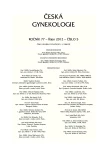HE4 a biomarker of ovarian cancer
Authors:
Jiří Presl 1
; R. Kučera 2; O. Topolčan 2; Z. Novotný 1; J. Vrzalová 2; R. Fuchsová 2; L. Betincová 1; Z. Rokyta 1
Authors‘ workplace:
Gynekologicko-porodnická klinika LF UK a FN Plzeň, přednosta doc. MUDr. Z. Novotný, CSc.
1; Imunoanalytická laboratoř LF UK a FN Plzeň, přednosta prof. MUDr. O. Topolčan, CSc.
2
Published in:
Ceska Gynekol 2012; 77(5): 445-449
Overview
Objective:
Verification of the importance of determination of HE4 and calculation of ROMA index for increasing the efficiency of diagnosis of ovarian cancer in a population of Czech women.
Design:
Prospective study.
Setting:
Department of Gynaecology and Obstetrics, Faculty Hospital in Pilsen.
Methods:
In the period from 06/24/2010 to 12/01/2011 was at the Department of Gynaecology and Obstetrics, University Hospital Pilsen examined 552 patients with abnormalities in the pelvis. Patients were divided into two groups. There were 30 women with histologically confirmed malignant ovarian tumors. Another 522 women had benign findings. According to the levels of FSH were women in both groups divided into premenopausal and postmenopausal. At all women were measured CA 125, HE4 and FSH. HE4 and CA125 were determined using the chemiluminescent device Architect 1000 (Abbott, USA), FSH chemiluminescent method on the device DXI 800 (Beckman Coulter, USA). At all premenopausal women was calculated ROMA1 index and at all postmenopausal women ROMA2 index. SAS statistical software 9.2 were used for all statistical calculations.
Results:
The highest diagnostic efficiency was achieved by a combination of HE4 and CA125 markers with the calculation ROMA2 index for postmenopausal women. In determining of menopausal status according to the values of FSH cut-off for menopause 40 IU/L and cut-off at 26.4% for ROMA2 reaches ROMA2 sensitivity of 92.3%, specificity of 88.5% and PV- of 99.3%. If we reduce the cut-off for laboratory diagnosis of menopause using FSH at 22 IU/L, and cut-off for ROMA2 was 26.3% reaches ROMA2 sensitivity of 95.2%, specificity of 87.8% and PV- of 99.5%.
Conclusion:
HE4 in combination with CA125 and current ROMA index calculation is a suitable methodology to improve the detection of ovarian cancer.
Key words:
HE4, CA125, ROMA index, ovarian cancer, menopausal status.
Sources
1. Cibula, D., Petruželka, L. Onkogynekologie. 1. vyd. Praha: Grada, 2009, 614 s.
2. Čepický, P., Burdová, M., Cibula, D., et al. Doporučení k hormonální terapii a substituci perimenopauzy a postmenopauzy. Čes Gynek, 2006, 71, 2, s. 150–152.
3. Fritsche, HA., Bast, RC. CA 125 in ovarian cancer: advances and controversy. Clin Chem, 1988, 44, p. 1379–1380.
4. Hellstrom, I., Raycraft, J., Hayden-Ledbetter, M., et al. The HE4 (WFDC2) protein is a biomarker for ovarian carcinoma. Cancer Res, 2003, 63, p. 3695–3700.
5. Chang, X., Ye, X., Dong, L., et al. Human epididymis protein 4 (HE4) as a serum tumor biomarker in patients with ovarian carcinoma. Int J Gynecol Cancer, 2011, 21 (5), p. 852–858.
6. Jurga, LM. Klinická a radiačná onkológia prvý a druhý diel. 1. vyd. Martin: Osveta, 2010, 2432 s.
7. Li, J., Dowdy, S., Tipton, T., et al. HE4 as a biomarker for ovarian and endometrial cancer management. Expert Rev Mol Diagn, 2009, 9, p. 555–566.
8. Moore, RG., Brown, AK., Miller, MC., et al. The use of multiple novel tumor biomarkersfor the detection of ovarian carcinoma in patients with a pelvic mass. Gynecol Oncol, 2008, 108, p. 402–408.
9. Moore, RG., McMeekin, DS., Brown, AK., et al. A novel multiple marker bioassay utilizing HE4 and CA125 for the prediction of ovarian cancer in patients with a pelvic mass. Gynecol Oncol, 2009, 112, p. 40–46.
10. Moore, RG., Miller MC., Disilvestro, P., et al. Evaluation of the diagnostic accuracy of the risk of ovarian malignancy algorithm in women with a pelvic mass. Obstet Gynecol, 2011, 118, p. 280–288.
11. Moore, RG., Jabre-Raughley, M., Brown, AK., et al. Comparison of a novel multiple marker assay vs the risk of malignancy index for the prediction of epithelial ovarian cancer in patients with a pelvic mass. Am J Obstet Gynecol, 2010, 203, p. 228.e1–6.
12. Partheen, K., Kristjansdottir, B., Sundfeldt, K. Evaluation of ovarian cancer biomarkers HE4 and CA-125 in women presenting with a suspicious cystic ovarian mass. J Gynecol Oncol, 2011, 22, p. 244–252.
13. ÚZIS (Národní onkologický registr ČR). Novotvary 2009 ČR. Praha: ÚZIS Zdravotnická statistika, 2012.
Labels
Paediatric gynaecology Gynaecology and obstetrics Reproduction medicineArticle was published in
Czech Gynaecology

2012 Issue 5
Most read in this issue
- Outcomes of anterior vaginal wall repair using polypropylene mesh
- HE4 a biomarker of ovarian cancer
- Intrauterine system (Mirena) and ectopic pregnancy – case report
- Prevalence of Chlamydia trachomatis infection in patients treated for infertility
